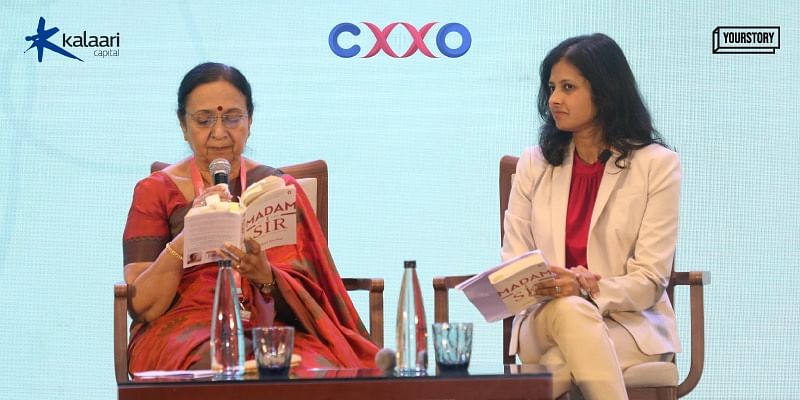How does a woman IPS officer fit into the man’s world of policing and keeping criminals in check? Well, Manjari Jaruhar, the first woman IPS officer from Bihar and author of the recently released book ‘Madam Sir’ has proved naysayers in the higher echelons wrong.
Manjari is among the first five women police officers in India and the first from the state of Bihar to join the country’s elite police cadre. She has also been the recipient of the Government of India’s Police Medal for Meritorious Service and the President’s Police Medal for Distinguished Service.
During the first edition of the ‘No Ceiling Summit’, organised by Kalaari Capital’s CXXO initiative and YourStory, Manjari Jaruhar – Advisor at Private Security Industry Committee, FICCI and Advisor to Tata Consultancy Services – talked about her life and journey and read excerpts from her book.
“A leader is one who is disciplined, and driven by integrity, values and morals. A leader’s job is to make a decision, give direction to team members and show them the correct path,” she said.
Standing tall in a man’s world
Like any other daughter in India, Manjari was also groomed to become an ideal housewife from childhood. Eldest of four siblings, Manjari went to a convent school and was taught embroidery. Apart from ensuring her grades were good in school, Manjari’s mother made sure that she knows stitching and cooking – the most desired qualities of an ideal housewife. “I was not taught any of these skills to get a job. I was always told that if I learn all the jobs that a housewife is supposed to do, I will find a good husband,” Manjari told Neha Bagaria, Founder and CEO, JobsForHer, who was the moderator of the fireside chat.
By the age of 19, Manjari was already married. “For some reason, that marriage did not work but it changed my approach towards life. I decided to take charge of my life, rather than relying on my parents,” she added. That was the turning point of her life. “I had many family members who were IAS and IPS officers. Knowing that these were respectable jobs, I decided to prepare for IPS,” said Manjari.
She went to Delhi and joined Rau’s IAS Study Circle to prepare for the Civil Services Entrance Exam. In 1976, Manjari qualified and became the first woman IPS officer from Bihar and one of the first five women police officers in India.
Talking about what pushed Manjari to move ahead in her career, she said, “Throughout my career, the plight of women, especially when they have fallen victims of the patriarchal society and cruel practices have had a profound impact on me. It was as if the eyes of those girls were haunting me, spurring me to seek justice on their behalf.”
The case that left a mark
Manjari’s first assignment was at the ASP Danapur in Bihar, when she found a young woman’s body severely burned and was being taken to the river for disposal after she was reportedly killed by her in-laws.
Upon enquiry, Manjari found multiple letters sent by the woman over a period to her parents. Those letters talked about how the young woman was tortured by her husband and in-laws. “This girl came from a very poor family and her father told me that the girl was murdered as they could not satisfy their greed for more dowry,” added Manjari.
While the dead woman’s in-laws were in custody for the murder charge, the woman’s parents visited the police station and pleaded to Manjari to withdraw the case. And, the reason cited by the victim’s parents left Manjari shocked. “Even after all these decades later, I still remember that old man standing before me with his palms folded, tears streaming down his face, begging me not to prosecute his murderer son-in-law because he has agreed to marry the poor father’s other daughter. Of course, as a professional, I could not allow justice to be derailed by the devious scheme of the accused to escape punishment,” added Manjari, quoting from her book.
Is the scenario still the same now, in 2022?
Answering the question, Manjuri said that she is not sure if situations have changed much in rural India. But, she feels the law has become more stringent and Section 498A has given some relief to women. However, it gives relief to a woman only after they have suffered. “Suffering of women still continues in our society,” said Manjari.
A piece of advice from the ‘Madam Sir’
Talking about the story behind the salutation – Madam Sir – Manjari said that while there is a lot of pop culture depicting women officers today, back in the 1970s, seeing a woman in uniform was a bitter pill to digest for many people. “Back then, men did not know how to react when they saw a woman wearing a khaki shirt-pant, belt and cap … The presence of a woman police officer has given rise to a peculiar confusion within the subordinate ranks. Officers were always addressed with the utmost respect by their juniors as ‘Saheb’ or ‘Huzoor’ in those days. But, what do they call a woman officer? The constabulary came up with a unique coinage – Madam Sir,” shared Manjari.
Manjari shared a piece of advice to all those women who feel victimised by the patriarchal norms and traditions. “If something has gone wrong in your life, take it up as a challenge and get over it. Avoid being regretful or feeling distressed, humiliated and frustrated. Put your negative thoughts behind you and move ahead in life,” she advised.










